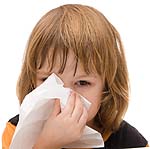Croup: Signs and Symptoms, Diagnosis,
Treatment and Prevention

Croup is an inflammation of the upper airway, causing swelling around the vocal cords and windpipe. When air is pushed through this narrowed passage, it causes the vocal cords to vibrate, resulting in a barking cough.
Croup is usually caused by the parainfluenza virus or the measles virus. It develops quickly in children younger than 5 years old. In most cases it clears up within a week.
Contagiousness:
Children can contract viruses causing croup through airborne infected respiratory droplets. Virus particles can also survive on toys and other surfaces.
Croup mostly occurs during winter and early spring and symptoms are most severe in children aged 3 and younger.
Children born prematurely have an increased risk of contracting croup.
Signs and Symptoms:
- Stuffy or runny nose and a slight fever
- Hoarseness
- Noisy breathing
- A harsh, barking cough
- In severe cases there might be a squeaking noise when breathing in. The child will breathe very fast and the skin between the ribs may seem to pull during breathing.
Symptoms tend to worsen at night, even though most cases of croup are mild.
Diagnosis:
Diagnosis is usually made based on the symptoms this disease presents, specifically the harsh, barking cough.
The doctor will take a medical history and ask whether the child has had croup or other respiratory conditions before or if the child has recently had a viral infection (e.g. measles).
The doctor will also do a physical exam, during which he will listen to the child's lungs and examine the throat.
In severe cases of croup, a doctor will order X-rays.
Treatment:
When croup is caused by a viral infection, treatment is symptomatic.
- Breathing in moist air usually relieves many of the symptoms.
- Breathing in cold air also helps, because cool air can decrease the swelling of the airway and surrounding tissue.
- Crying makes coughing worse, so it is imperative to keep yourself and the child calm.
- Sitting and sleeping propped up against pillows can make breathing easier.
- Avoid heavy meals, since coughing can induce vomiting.
- Ibuprofen can help bring down fever and reduce pain.
- Ensure that the child gets plenty of fluids.
- Sleeping and rest are 2 very important tools for combating any infection.
Children who have severe symptoms or complications may be given corticosteroids to strengthen their lungs, adrenaline through inhalation to open airways, and/or oxygen. Children, who present severe breathing difficulties etc., might be hospitalized for observation.
Complications:
Most children recover from croup without any complications. However, children who were born prematurely or who have a history of lung disease (like asthma) are more likely to develop croup related complications such as:
- Pneumonia
- Severe breathing problems
- Lack of oxygen
- Airway obstructions
Prevention:
Take the same precautions you would take to prevent colds and flu:
- Avoid contact with sick people.
- Encourage frequent and thorough hand washing.
- Keep immunizations up to date.
When is croup a medical emergency?
- Your child has severe breathing difficulties.
- Nails and lips turn blue.
- The area surrounding the mouth and nose turn blue.
- The child makes high-pitched breathing sounds when inhaling.
- The child drools or has difficulty swallowing.
- The child is more agitated or irritable than usual.
- The skin between the ribs pull with each breath.
- Breathing becomes rapid and the stomach 'sinks' with every breath.
- Fever rises above 38,5ºC.
- The child becomes increasingly lethargic (tired). This could be an indication of oxygen deprivation.
If you observe any of the above in your child, it is vital that you take the child to an emergency room ASAP.
Author: Annemien van Staden
Copyright 2008: Remedium. This article may not be copied, in whole or in part, without the written consent of Remedium.
|